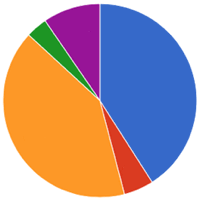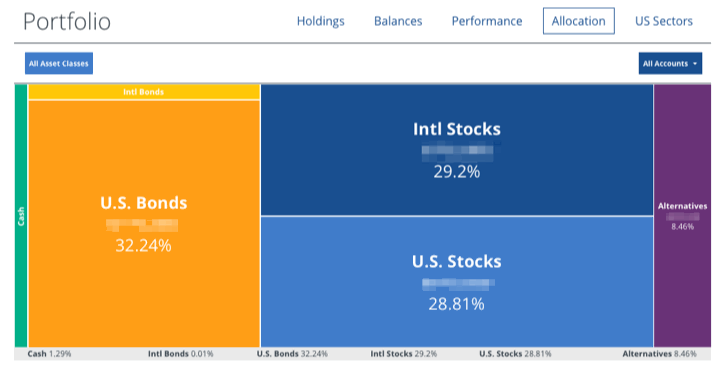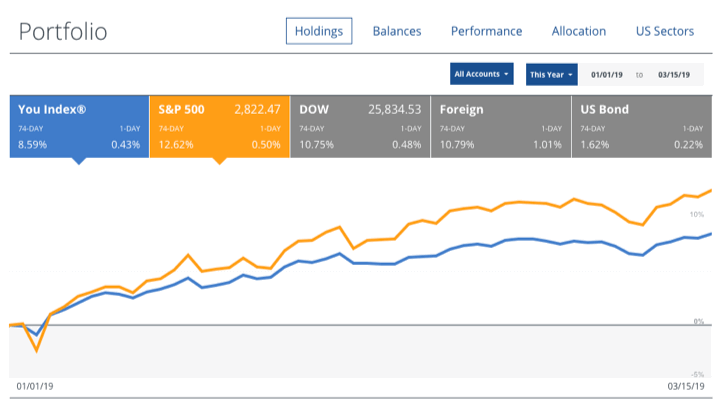
Here’s my quarterly portfolio update for Q1 2019. Most of my dividends arrive on a quarterly basis, and this helps me decided where to reinvest them. These are my real-world holdings, including 401k/403b/IRAs and taxable brokerage accounts but excluding our house, cash reserves, and a few side investments. The goal of this portfolio is to create sustainable income to cover our household expenses for the next (hopefully) 40+ years. We are currently “semi-retired”, meaning we both work part-time while also spending a portion of our dividends and interest from this portfolio.
Actual Asset Allocation and Holdings
I use both Personal Capital and a custom Google Spreadsheet to track my investment holdings. The Personal Capital financial tracking app (free, my review) automatically logs into my accounts, adds up my balances, tracks my performance, and calculates my asset allocation. I still use my manual Google Spreadsheet (free, instructions) because it helps me calculate how much I need in each asset class to rebalance back towards my target asset allocation.
Here are my YTD performance and current asset allocation visually, per the “Holdings” and “Allocation” tabs of my Personal Capital account, respectively:


Stock Holdings
Vanguard Total Stock Market Fund (VTI, VTSMX, VTSAX)
Vanguard Total International Stock Market Fund (VXUS, VGTSX, VTIAX)
WisdomTree SmallCap Dividend ETF (DES)
Vanguard Small Value ETF (VBR)
Vanguard Emerging Markets ETF (VWO)
Vanguard REIT Index Fund (VNQ, VGSIX, VGSLX)
Bond Holdings
Vanguard Limited-Term Tax-Exempt Fund (VMLTX, VMLUX)
Vanguard Intermediate-Term Tax-Exempt Fund (VWITX, VWIUX)
Vanguard Intermediate-Term Treasury Fund (VFITX, VFIUX)
Vanguard Inflation-Protected Securities Fund (VIPSX, VAIPX)
Fidelity Inflation-Protected Bond Index Fund (FIPDX)
iShares Barclays TIPS Bond ETF (TIP)
Individual TIPS securities
U.S. Savings Bonds (Series I)
Target Asset Allocation. Our overall goal is to include asset classes that will provide long-term returns above inflation, distribute income via dividends and interest, and finally offer some historical tendencies to balance each other out. I make a small bet that US Small Value and Emerging Markets will have higher future long-term returns (along with some higher volatility) than the more large and broad indexes, although I could be wrong. I don’t hold commodities, gold, or bitcoin as they don’t provide any income and I don’t believe they’ll outpace inflation significantly.
I believe that it is important to imagine an asset class doing poorly for a long time, with bad news constantly surrounding it, and only hold the ones where you still think you can maintain faith based on a solid foundation of knowledge and experience.
Stocks Breakdown
- 38% US Total Market
- 7% US Small-Cap Value
- 38% International Total Market
- 7% Emerging Markets
- 10% US Real Estate (REIT)
Bonds Breakdown
- 50% High-quality, Intermediate-Term Bonds
- 50% US Treasury Inflation-Protected Bonds
I have settled into a long-term target ratio of 67% stocks and 33% bonds (2:1 ratio) within our investment strategy of buy, hold, and occasionally rebalance. I will use the dividends and interest to rebalance whenever possible in order to avoid taxable gains. (I’m fine with it drifting to 65/35 or 70/30.) With a self-managed, simple portfolio of low-cost funds, we minimize management fees, commissions, and taxes.
Holdings commentary. On the bond side, I still like high-quality bonds with a short-to-intermediate duration of under 5 years or so. This means US Treasuries, TIPS, or investment-grade municipal bonds. I don’t want to worry about my bonds “blowing up”. Right now, my bond portfolio is about 1/3rd muni bonds, 1/3rd treasury bonds, and 1/3rd inflation-linked treasury bonds (and savings bonds).
On the stocks side, everything has had a nice bounce back up since the drop in late 2018. I didn’t really sweat the ride down, so I’m not celebrating the ride up. I remain satisfied with my mix, knowing that I will own whatever successful businesses come out of the US, China, or wherever in the future.
Performance commentary and benchmarks. According to Personal Capital, my portfolio went up 8.6% already so far in 2019. I see that during the same period the S&P 500 has gone up over 12%, Foreign Developed stocks up nearly 11%, and the US Aggregate bond index was up nearly 2%.
An alternative benchmark for my portfolio is 50% Vanguard LifeStrategy Growth Fund and 50% Vanguard LifeStrategy Moderate Growth Fund – one is 60/40 and the other is 80/20 so it also works out to 70% stocks and 30% bonds. That benchmark would have a total return of +8.6% for 2019 YTD. This quarter, I’m right at this benchmark with my customized portfolio.
I’ll share about more about the income aspect in a separate post.
 The Best Credit Card Bonus Offers – 2025
The Best Credit Card Bonus Offers – 2025 Big List of Free Stocks from Brokerage Apps
Big List of Free Stocks from Brokerage Apps Best Interest Rates on Cash - 2025
Best Interest Rates on Cash - 2025 Free Credit Scores x 3 + Free Credit Monitoring
Free Credit Scores x 3 + Free Credit Monitoring Best No Fee 0% APR Balance Transfer Offers
Best No Fee 0% APR Balance Transfer Offers Little-Known Cellular Data Plans That Can Save Big Money
Little-Known Cellular Data Plans That Can Save Big Money How To Haggle Your Cable or Direct TV Bill
How To Haggle Your Cable or Direct TV Bill Big List of Free Consumer Data Reports (Credit, Rent, Work)
Big List of Free Consumer Data Reports (Credit, Rent, Work)
Maybe you’ve talked about this elsewhere but you seem to have a pretty high percentage of your holdings in international stocks, I guess that is working for you in terms of reward vs risk?
I write about it from time to time as it is a constant debate in investing (often colored by recent past performance), but here is one of my more recent posts on the topic:
https://www.mymoneyblog.com/how-much-international-stocks-2017-outlook.html
Im curious how well your portfolio tracked over its lifetime as compared to S&P 500. It looks like investing in a total market fund from vanguard would have been better this year — so im curious if it remained to be true over time for you
Jonathan…I still can’t get a handle on your strategy especially if you define yourself as an income investor. Not to pick your portfolio apart but many of your Vanguard Funds haven’t moved anywhere but sideways for 5 years. Most, not including the REITS have yields below 3% and many are less then 2%, FIPDX is not even 1%.
I understand conservative and income preservation but up until 2009 there was hardly a CD that couldn’t generate more income then many of these funds. If your approach is to have a reliable base and cash in at some point on the returns from the stock funds I’d still say that is an iffy strategy and may end up looking like the unhappy ending of the housing bubble in 2009. If your portfolio is in the $3-$7 million range maybe it doesn’t matter. But my experience is, picking your own corporate bonds, high quality Preferreds and strong dividend paying stocks along with a significant holding of 3%+ CDs and a few Utilities bought at the right time….generates more income, gives you more consistency, control and ability to react quickly if necessary.
Everyone is technically an income investor eventually (we’re all trying to pay the bills without working), just like everyone is technically a value investor (who doesn’t want the most for their money?).
I’m not really here to advocate for my portfolio, I think everyone needs to do their own research and find something that they can manage through both good times and bad times. I’m just sharing regularly because too many people just point out their good picks that went well recently, but you rarely hear people point out their bad picks. Lots of stuff sounds good, until it doesn’t.
I could easily up the yield of my portfolio, but I don’t think that reaching for increased yield comes without paying a price in terms of increased downside risk and/or impaired upside potential. If I were to want a higher yield, I don’t think your idea is bad. It’s similar to the Wellington/Wellesley method – a portfolio of 2/3 blue-chip dividend-paying stocks and 1/3 higher-yielding corporate bonds.
I like to think that I am first optimizing for highest total return and THEN spending the yield (dividends and interest income).
Looking at your Google Spreadsheet, what is the difference between the Overall AA and the Target %?
Vanguard Total Stock Market Fund includes REITs. What’s your reason for holding Vanguard REIT Index Fund?
Curious why you own REITs if it’s already included inside your Total Stock Market Fund?
I like the idea of real estate exposure and it is my opinion that REITs are structurally different than other public equities and thus will act differently. They are taxed differently. 90% of their income is required to be distributed every year. More here:
https://www.mymoneyblog.com/reit-primer.html
REITs are about 4% of the Total Stock Market fund the last time I checked, which means my portfolio would only have a 1% allocation to REITs if I didn’t add it in separately. That’s really not much exposure. I chose to add in another 7% or so, so that REITs make up about 8% of the total portfolio.